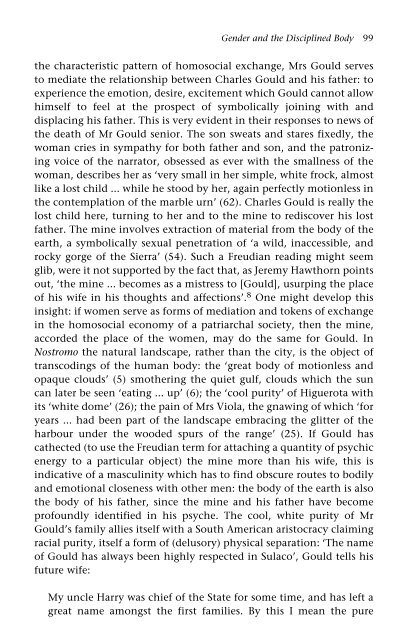Conrad and Masculinity
Conrad and Masculinity
Conrad and Masculinity
Create successful ePaper yourself
Turn your PDF publications into a flip-book with our unique Google optimized e-Paper software.
Gender <strong>and</strong> the Disciplined Body 99<br />
the characteristic pattern of homosocial exchange, Mrs Gould serves<br />
to mediate the relationship between Charles Gould <strong>and</strong> his father: to<br />
experience the emotion, desire, excitement which Gould cannot allow<br />
himself to feel at the prospect of symbolically joining with <strong>and</strong><br />
displacing his father. This is very evident in their responses to news of<br />
the death of Mr Gould senior. The son sweats <strong>and</strong> stares fixedly, the<br />
woman cries in sympathy for both father <strong>and</strong> son, <strong>and</strong> the patronizing<br />
voice of the narrator, obsessed as ever with the smallness of the<br />
woman, describes her as ‘very small in her simple, white frock, almost<br />
like a lost child ... while he stood by her, again perfectly motionless in<br />
the contemplation of the marble urn’ (62). Charles Gould is really the<br />
lost child here, turning to her <strong>and</strong> to the mine to rediscover his lost<br />
father. The mine involves extraction of material from the body of the<br />
earth, a symbolically sexual penetration of ‘a wild, inaccessible, <strong>and</strong><br />
rocky gorge of the Sierra’ (54). Such a Freudian reading might seem<br />
glib, were it not supported by the fact that, as Jeremy Hawthorn points<br />
out, ‘the mine ... becomes as a mistress to [Gould], usurping the place<br />
of his wife in his thoughts <strong>and</strong> affections’. 8 One might develop this<br />
insight: if women serve as forms of mediation <strong>and</strong> tokens of exchange<br />
in the homosocial economy of a patriarchal society, then the mine,<br />
accorded the place of the women, may do the same for Gould. In<br />
Nostromo the natural l<strong>and</strong>scape, rather than the city, is the object of<br />
transcodings of the human body: the ‘great body of motionless <strong>and</strong><br />
opaque clouds’ (5) smothering the quiet gulf, clouds which the sun<br />
can later be seen ‘eating ... up’ (6); the ‘cool purity’ of Higuerota with<br />
its ‘white dome’ (26); the pain of Mrs Viola, the gnawing of which ‘for<br />
years ... had been part of the l<strong>and</strong>scape embracing the glitter of the<br />
harbour under the wooded spurs of the range’ (25). If Gould has<br />
cathected (to use the Freudian term for attaching a quantity of psychic<br />
energy to a particular object) the mine more than his wife, this is<br />
indicative of a masculinity which has to find obscure routes to bodily<br />
<strong>and</strong> emotional closeness with other men: the body of the earth is also<br />
the body of his father, since the mine <strong>and</strong> his father have become<br />
profoundly identified in his psyche. The cool, white purity of Mr<br />
Gould’s family allies itself with a South American aristocracy claiming<br />
racial purity, itself a form of (delusory) physical separation: ‘The name<br />
of Gould has always been highly respected in Sulaco’, Gould tells his<br />
future wife:<br />
My uncle Harry was chief of the State for some time, <strong>and</strong> has left a<br />
great name amongst the first families. By this I mean the pure




